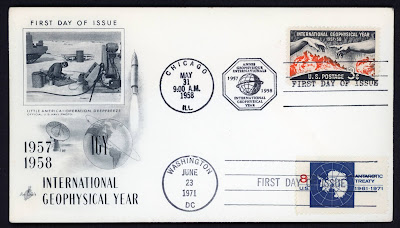I was going to post next on the design of the U.S. IGY stamp, but I decided to delay that to again take my prompt from today's New York Times crossword. The revealer at the center of the puzzle was "polar opposite", as clued by "One totally unlike another ... or what each answer on the edge of this puzzle has".
 |
The first cover comprises two first day cancellations of the IGY stamps from two countries, the U.S. and Canada. The stamps and their cancellations are in "polar opposite" catty-corner positions of the cover. Both countries do have geographic areas north of the Arctic Circle. So, polar opposites? I'll return to the Canada stamp at some point. Its issue date of March 5, 1958, predates the U.S. stamp by almost three months. I like the bilingual FDOI slogan. If you look at the back of the envelope, Canada is right-side up.
 |
| Two FDOI cancellations on the same cover, for U.S. and Canada IGY Stamps |
 |
| Two FDOI cancellations of the U.S. IGY and Antarctic treaty stamps |
The third cover again contains the 1958 U.S. IGY stamp, but also two stamps issued during the 2007-08 Fourth International Polar Year, 50 years after the IGY. The IGY itself was also the Third International Polar Year. Not only do the stamps from the two eras show the solar and ionospheric environments, respectively, but the two IPY auroral stamps are for both the Northern (boreal) and Southern (austral) lights, polar opposites you might (?) say. The cancellations are much clearer than for some of my covers. The logos for the IGY and IPY are the de facto cachets on this cover.
 |
| A cover showing FDOI cancellations for the U.S. 1958 IGY stamp and two 2007 84¢ IPY stamps |
 |
| Back of cover, showing remainder of souvenir sheet for the IPY stamps |
The excellent book, Topical Adventures: A Guide to Topical and Thematic Stamp Collecting (Jack R. Congrove, Dawn R. Hammer, and Martin Kent Miller, eds.; American Topical Association, Handbook #168, 2020, 190 p.), says on p. 72:
Covers, mostly philatelically contrived but sometimes not, used on a stamp's first day of issue are highly collectible, especially when accompanied by a colorful cachet.
From a philatelic standpoint, you could say these covers with double FDOI cancellations are indeed contrived, or at least my interpretations of them are, but I like them!
No comments:
Post a Comment